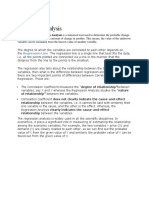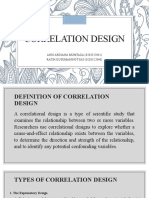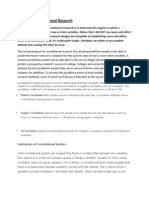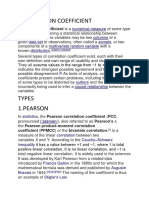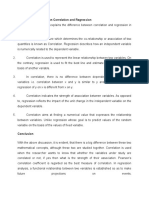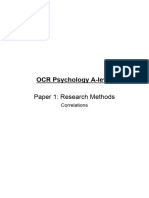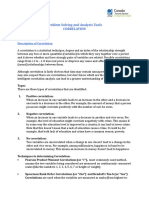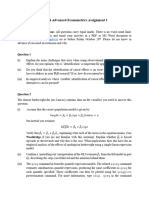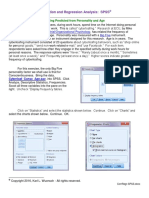0 ratings0% found this document useful (0 votes)
22 viewsCorrelational Research
Correlational Research
Uploaded by
Jenny Rose Peril CostillasThe document discusses an introduction to correlational research in Psych 108, explaining that correlational research examines relationships between two or more variables through correlation coefficients and scatterplots, establishing associations but not causation, and examples of how correlational designs can be used for prediction, evaluating theories, and addressing research questions.
Copyright:
© All Rights Reserved
Available Formats
Download as DOCX, PDF, TXT or read online from Scribd
Correlational Research
Correlational Research
Uploaded by
Jenny Rose Peril Costillas0 ratings0% found this document useful (0 votes)
22 views3 pagesThe document discusses an introduction to correlational research in Psych 108, explaining that correlational research examines relationships between two or more variables through correlation coefficients and scatterplots, establishing associations but not causation, and examples of how correlational designs can be used for prediction, evaluating theories, and addressing research questions.
Original Description:
Summary
Copyright
© © All Rights Reserved
Available Formats
DOCX, PDF, TXT or read online from Scribd
Share this document
Did you find this document useful?
Is this content inappropriate?
The document discusses an introduction to correlational research in Psych 108, explaining that correlational research examines relationships between two or more variables through correlation coefficients and scatterplots, establishing associations but not causation, and examples of how correlational designs can be used for prediction, evaluating theories, and addressing research questions.
Copyright:
© All Rights Reserved
Available Formats
Download as DOCX, PDF, TXT or read online from Scribd
Download as docx, pdf, or txt
0 ratings0% found this document useful (0 votes)
22 views3 pagesCorrelational Research
Correlational Research
Uploaded by
Jenny Rose Peril CostillasThe document discusses an introduction to correlational research in Psych 108, explaining that correlational research examines relationships between two or more variables through correlation coefficients and scatterplots, establishing associations but not causation, and examples of how correlational designs can be used for prediction, evaluating theories, and addressing research questions.
Copyright:
© All Rights Reserved
Available Formats
Download as DOCX, PDF, TXT or read online from Scribd
Download as docx, pdf, or txt
You are on page 1of 3
Hello!
Welcome back to Psych 108 (Field Methods in Psychology).
Today we will be discussing about the Introduction to Correlational
Research
Correlation means that there is a relationship between two or more
variables, but this relationship does not necessarily imply cause and
effect.
The goal of the correlational research strategy is to examine and
describe the associations and relationships between variables. More
specifically, the purpose of a correlational study is to establish that a
relationship exists between variables and to describe the nature of the
relationship
When two variables are correlated, it simply means that as one
variable changes, so does the other.
We can measure correlation by calculating a statistic known as a
correlation coefficient.
A correlation coefficient is a number from -1 to +1 that indicates the
strength and direction of the relationship between variables. The
correlation coefficient is usually represented by the letter r.
The closer the number is to 1 (be it negative or positive), the more
strongly related the variables are, and the more predictable changes in
one variable will be as the other variable changes.
The closer the number is to zero, the weaker the relationship, and
relationship between the variables becomes less predictable.
The sign—positive or negative—of the correlation coefficient
indicates the direction of the relationship
A positive correlation means that the variables move in the same
direction. When one variable increases so does the other, and
conversely, when one variable decreases so does the other
A negative correlation means that the variables move in opposite
directions. If two variables are negatively correlated, a decrease in one
variable is associated with an increase in the other and vice versa.
Scatterplots are a graphical view of the strength and direction of
correlations. The stronger the correlation, the closer the data points are
to a straight line. It is a figure showing the relationship between two
variables, graphically represents a correlation coefficient.
The lines drawn on the scatterplots are called regression lines, or lines
of best fit. They illustrate the mathematical equation that best
describes the linear relationship between the two measured scores. The
direction of the lines corresponds to the direction of the relationship.
As noted earlier, the correlational design is used to identify and
describe relationships between variables. Following are three
examples of how correlational designs can be used to address research
questions.
Example # 1: Applications of Correlational Strategy
One important use of correlational research is to establish a
relationship between variables that can be used for purposes of
prediction
The use of correlational results to make predictions is not limited to
predictions about future behavior. Whenever two variables are
consistently related, it is possible to use knowledge of either variable
to help make predictions about the other.
By establishing and describing the existence of a relationship,
correlational studies provide the basic information needed to make
predictions
Correlational studies often identify one variable as the predictor
variable and the second variable as the criterion variable. One variable
(the predictor) is used to predict the other (the criterion).
The statistical process for using one variable to predict another is
called regression. The goal here is to find the equation that produces
the most accurate predictions of Y (the criterion variable) for each
value of X (the predictor variable).
Both reliability and validity are commonly defined by relationships
that are established using the correlational research design.
For example, test–retest reliability is defined by the relationship
between an original set of measurements and a follow-up set of
measurements. If the same individuals are measured twice under the
same conditions, and there is a consistent relationship between the two
measurements, then the measurement procedure is said to be reliable.
Many theories generate research questions about the relationships
between variables that can be addressed by the correlational research
design (evaluating theories)
Correlational research design is being used to address a theoretical
issue.
Strengths and Weaknesses
Correlational Research is often misinterpreted - Correlation Does Not
Indicate Causation. Correlational research is useful because it allows
us to discover the strength and direction of relationships that exist
between two variables (this is a strength/PRO)
However, correlation is limited because establishing the existence of a
relationship tells us little about cause-and-effect (this is a
weakness/CON)
While variables are sometimes correlated because one does cause the
other, it could also be that some other factor, a confounding variable,
is actually causing the systematic movement in our variables of
interest (third variable problem, this is another weakness/CON).
In addition to describing a relationship, correlations allow us to make
predictions from one variable to another (this is a strength/PRO)
One of the primary advantages of a correlational study is that the
researcher simply records what exists naturally. Because the
researcher does not manipulate, control, or otherwise interfere with the
variables being examined or with the surrounding environment, there
is good reason to expect that the measurements and the
relationships accurately reflect the natural events being examined
(this is a strength/PRO) – high external validity.
Correlational study usually does not produce a clear and unambiguous
explanation for the relationship (this is a weakness/CON) – low
internal validity
I hope you will continue to enjoy learning in this course.
Have a fun-filled learning :)
You might also like
- Multiple Regression Analysis Using SPSS StatisticsDocument9 pagesMultiple Regression Analysis Using SPSS StatisticsAmanullah Bashir GilalNo ratings yet
- Time Series Analysis Project - CAC 40 - 2018Document33 pagesTime Series Analysis Project - CAC 40 - 2018HofidisNo ratings yet
- CSU - Week 2.2 Script - Correlational ResearchDocument3 pagesCSU - Week 2.2 Script - Correlational Researchjaneclou villasNo ratings yet
- Correlation: CharcteristicsDocument6 pagesCorrelation: CharcteristicsBhuv SharmaNo ratings yet
- Correlation, Correlational Studies, and Its Methods: Mariah Zeah T. Inosanto, RPMDocument39 pagesCorrelation, Correlational Studies, and Its Methods: Mariah Zeah T. Inosanto, RPMMariah ZeahNo ratings yet
- Research Methodology AssignmentDocument2 pagesResearch Methodology AssignmentiKonic blinkNo ratings yet
- Assignment On Correlation Analysis Name: Md. Arafat RahmanDocument6 pagesAssignment On Correlation Analysis Name: Md. Arafat RahmanArafat RahmanNo ratings yet
- STATISTICS DocumentaryDocument18 pagesSTATISTICS Documentarykeerthikabalasubramanian7No ratings yet
- Simple Correlation Converted 23Document5 pagesSimple Correlation Converted 23Siva Prasad PasupuletiNo ratings yet
- Wub AnteDocument8 pagesWub Antecolocadojordan283No ratings yet
- Etha Seminar Report-Submitted On 20.12.2021Document12 pagesEtha Seminar Report-Submitted On 20.12.2021AkxzNo ratings yet
- Regression Analysis: Definition: The Regression Analysis Is A Statistical Tool Used To Determine The Probable ChangeDocument12 pagesRegression Analysis: Definition: The Regression Analysis Is A Statistical Tool Used To Determine The Probable ChangeK Raghavendra Bhat100% (1)
- Correlation Research Design - PRESENTASIDocument62 pagesCorrelation Research Design - PRESENTASIDiah Retno Widowati100% (1)
- Correlation: 1. Definition of Correlational ResearchDocument4 pagesCorrelation: 1. Definition of Correlational ResearchLuckys SetiawanNo ratings yet
- Correlation DesignDocument25 pagesCorrelation DesignlidianaNo ratings yet
- Inferential Statistics (Inferential Statistics (Correlation AND PARTIAL-Correlation)Document28 pagesInferential Statistics (Inferential Statistics (Correlation AND PARTIAL-Correlation)Nurin EzatulNo ratings yet
- Correlation Analysis PDFDocument30 pagesCorrelation Analysis PDFtoy sanghaNo ratings yet
- Definition 3. Use of Regression 4. Difference Between Correlation and Regression 5. Method of Studying Regression 6. Conclusion 7. ReferenceDocument11 pagesDefinition 3. Use of Regression 4. Difference Between Correlation and Regression 5. Method of Studying Regression 6. Conclusion 7. ReferencePalakshVismayNo ratings yet
- PeterDocument48 pagesPeterPeter LoboNo ratings yet
- Purpose of Correlational ResearchDocument3 pagesPurpose of Correlational ResearchAmeer Bakhsh67% (3)
- Associative Hypothesis TestingDocument18 pagesAssociative Hypothesis TestingGresia FalentinaNo ratings yet
- Income TaxDocument9 pagesIncome TaxDeepshikha SonberNo ratings yet
- Correlational Research EssayDocument6 pagesCorrelational Research EssayfadhilNo ratings yet
- Correlational ResearchDocument19 pagesCorrelational ResearchEden Mae P. CabaleNo ratings yet
- QT-Correlation and Regression-1Document3 pagesQT-Correlation and Regression-1nikhithakleninNo ratings yet
- 1504677559module-33 Quadrant-IDocument17 pages1504677559module-33 Quadrant-ISachin KumarNo ratings yet
- Business Statistics Project On Correlation: Submitted by N.Bavithran BC0140018Document17 pagesBusiness Statistics Project On Correlation: Submitted by N.Bavithran BC0140018BaViNo ratings yet
- Correlational DesignDocument7 pagesCorrelational DesignBinte Afzal100% (2)
- Correlation CoefficientDocument7 pagesCorrelation CoefficientDimple PatelNo ratings yet
- Module 6 RM: Advanced Data Analysis TechniquesDocument23 pagesModule 6 RM: Advanced Data Analysis TechniquesEm JayNo ratings yet
- B. CORRELATION and REGRESSIONDocument4 pagesB. CORRELATION and REGRESSIONJeromeNo ratings yet
- StatisticsDocument21 pagesStatisticsVirencarpediemNo ratings yet
- Additional DamageDocument2 pagesAdditional DamageMoh SharmaNo ratings yet
- Unit 7 Infrential Statistics CorelationDocument10 pagesUnit 7 Infrential Statistics CorelationHafizAhmadNo ratings yet
- Key Differences Between Correlation and RegressionDocument2 pagesKey Differences Between Correlation and RegressionRemigi CosmasNo ratings yet
- Paper 1 - Research Methods - Correlational StudiesDocument4 pagesPaper 1 - Research Methods - Correlational Studieszatooni1No ratings yet
- Correlation and Regression Feb2014Document50 pagesCorrelation and Regression Feb2014Zeinab Goda100% (1)
- Correlation AnalysisDocument20 pagesCorrelation AnalysisVeerendra NathNo ratings yet
- Correlation: By: Jubing 5Document14 pagesCorrelation: By: Jubing 5Hy Hy RamandeyNo ratings yet
- Statistics Regression Final ProjectDocument12 pagesStatistics Regression Final ProjectHenry Pinolla100% (2)
- Lecture 29Document5 pagesLecture 29hrishabh_agrawalNo ratings yet
- Correlation and Regression Are The Two Analysis Based On Multivariate DistributionDocument10 pagesCorrelation and Regression Are The Two Analysis Based On Multivariate DistributionBernadeth TenorioNo ratings yet
- Correlational and Causal Comparative ResearchDocument37 pagesCorrelational and Causal Comparative ResearchLatha Dona VenkatesanNo ratings yet
- BSNL ResearchDocument3 pagesBSNL Researchkandeesh17No ratings yet
- Stati Unit 5Document8 pagesStati Unit 520BPS144 Sai Sowbharni B RNo ratings yet
- Topic 4.5 Correlational AnalysisDocument28 pagesTopic 4.5 Correlational AnalysisEmy AlinsodNo ratings yet
- Correlation: Self Instructional Study Material Programme: M.A. Development StudiesDocument21 pagesCorrelation: Self Instructional Study Material Programme: M.A. Development StudiesSaima JanNo ratings yet
- Stat BootCamp3Document30 pagesStat BootCamp3Hilmar Castro de GarciaNo ratings yet
- Correlation and RegressionDocument3 pagesCorrelation and RegressionSreya SanilNo ratings yet
- Correlation Rev 1.0Document5 pagesCorrelation Rev 1.0Ahmed M. HashimNo ratings yet
- SPSS AssignmentDocument3 pagesSPSS Assignmentpalakj1131No ratings yet
- CH5.Correlational and Quasi-Experimental DesignsDocument43 pagesCH5.Correlational and Quasi-Experimental DesignsNiel Ryan HizoleNo ratings yet
- Correlational ResearchDocument5 pagesCorrelational ResearchScribdTranslationsNo ratings yet
- Correlational ResearchDocument10 pagesCorrelational ResearchSari100% (1)
- 4 Research Design QodDocument2 pages4 Research Design Qodapi-308082215No ratings yet
- Statistical MethodsDocument4 pagesStatistical MethodsYra Louisse Taroma100% (1)
- Business Reseach MathodolegyDocument6 pagesBusiness Reseach Mathodolegymalavika nairNo ratings yet
- Correlation and Simple Linear Regression Analyses: ObjectivesDocument6 pagesCorrelation and Simple Linear Regression Analyses: ObjectivesMarianne Christie RagayNo ratings yet
- Correlation: (For M.B.A. I Semester)Document46 pagesCorrelation: (For M.B.A. I Semester)Arun Mishra100% (2)
- Applied Human Behavioural Power and Sexual Dynamics - The Book of Social and Sexual Dominance -From EverandApplied Human Behavioural Power and Sexual Dynamics - The Book of Social and Sexual Dominance -No ratings yet
- Class 5 Computer ExerciseDocument3 pagesClass 5 Computer Exercisemy2160No ratings yet
- Int 354Document4 pagesInt 354sjNo ratings yet
- Machine Learning Using Matlab: Lecture 8 Advice On ML ApplicationDocument30 pagesMachine Learning Using Matlab: Lecture 8 Advice On ML ApplicationmikostovNo ratings yet
- Credit Card DefaultDocument5 pagesCredit Card Defaultxujiexi0211No ratings yet
- Numerical Methods in Engineering: Dr. Ayşe Çağıl KANDEMİRDocument2 pagesNumerical Methods in Engineering: Dr. Ayşe Çağıl KANDEMİRSharif KamranNo ratings yet
- Measures of CorrelationDocument23 pagesMeasures of CorrelationPrabhneetNo ratings yet
- Statistical Tests For Comparative StudiesDocument7 pagesStatistical Tests For Comparative StudiesalohaNo ratings yet
- CH 11 TestDocument20 pagesCH 11 TestMahmoudAli100% (2)
- Multiple RegressionDocument67 pagesMultiple RegressionKhánh Đoan Lê ĐìnhNo ratings yet
- 816637086eco Alok 14JULYDocument2 pages816637086eco Alok 14JULYKaran PratapNo ratings yet
- Multiple Choice Question Subject-Engineering Mathematics-III Unit-III StatisticsDocument38 pagesMultiple Choice Question Subject-Engineering Mathematics-III Unit-III StatisticsA-z knowledgeNo ratings yet
- Sta 250 2022 Session 2Document9 pagesSta 250 2022 Session 2PUTERI AIESHA AHMAD NAZLEENo ratings yet
- Business Statistics: A Decision-Making Approach: Introduction To Linear Regression and Correlation AnalysisDocument64 pagesBusiness Statistics: A Decision-Making Approach: Introduction To Linear Regression and Correlation AnalysisInciaNo ratings yet
- EC374 Advanced Econometrics Assignment 1Document2 pagesEC374 Advanced Econometrics Assignment 1Paramjot PandaNo ratings yet
- AppendixB RegressionDocument29 pagesAppendixB RegressionRahulNo ratings yet
- Tahoe Salt Example From CM4e, Chapter 7: Quarterly DemandDocument17 pagesTahoe Salt Example From CM4e, Chapter 7: Quarterly DemandBrad HobsonNo ratings yet
- ECON 322 ECONOMETRICS II - Kabarak UniversityDocument4 pagesECON 322 ECONOMETRICS II - Kabarak University11803098danNo ratings yet
- Mean Absolute Error (MAE)Document3 pagesMean Absolute Error (MAE)okayshokayNo ratings yet
- One Whose Properties Do Not Depend On The Time at Which The Series Is ObservedDocument12 pagesOne Whose Properties Do Not Depend On The Time at Which The Series Is ObservedbadaltelNo ratings yet
- ρ r r Cov (X,Y) V (x) .V (Y) X X) (Y Y) X X n Y Y: xy xyDocument13 pagesρ r r Cov (X,Y) V (x) .V (Y) X X) (Y Y) X X n Y Y: xy xyStatistics and EntertainmentNo ratings yet
- Part 4 Modeling Profitability Instead of DefaultDocument5 pagesPart 4 Modeling Profitability Instead of DefaultWathek Al Zuaiby100% (7)
- Relationship Between The Set Outcome and Volleyball Skills in A Professional Volleyball Champion Male Team in Puerto RicoDocument4 pagesRelationship Between The Set Outcome and Volleyball Skills in A Professional Volleyball Champion Male Team in Puerto RicoAlrey UYNo ratings yet
- Top 100 ML Interview Q&ADocument39 pagesTop 100 ML Interview Q&Agsunanda038100% (1)
- Flight Delay Prediction System Paper - 802 - 826 - 828Document7 pagesFlight Delay Prediction System Paper - 802 - 826 - 828aepatil74No ratings yet
- Regression and CorrelationDocument12 pagesRegression and CorrelationAbdul RehmanNo ratings yet
- Jurusan Akuntansi, Fakultas Ekonomi Dan Bisnis, Universitas Sam Ratulangi, JL - Kampus Bahu, Manado, 95115, IndonesiaDocument10 pagesJurusan Akuntansi, Fakultas Ekonomi Dan Bisnis, Universitas Sam Ratulangi, JL - Kampus Bahu, Manado, 95115, IndonesiaPutri WahdahNo ratings yet
- Ch5 Slides Ed3 Feb2021Document49 pagesCh5 Slides Ed3 Feb2021Phuc Hong PhamNo ratings yet
- Sharma 1981Document10 pagesSharma 1981DANY CREATIONSNo ratings yet











